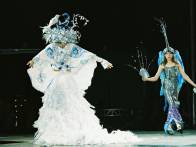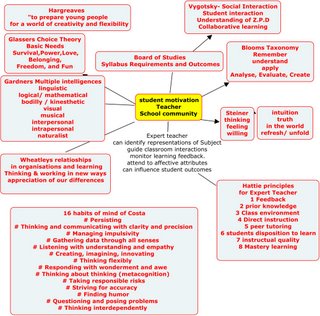Board of Studies

SCOPE & SEQUENCE.
what we want to achieve as teachers, in the time frame and process.
6 Aim
The Entertainment Industry Curriculum Framework is designed to enable students to acquire a range of technical, practical, personal and organisational skills valued both within and beyond the workplace. They will also acquire underpinning skills and knowledge related to work, employment and further training within the entertainment industry sector. Through study of this subject, students will gain experiences that can be applied to a range of contexts, including work, study and leisure and which can assist them in making informed career choices.
TEACHING PROGRAMME.
Programmes that emhance the Curriculum, are delivered in Creative Active ways, embrace the values of the school community, in our case Steiner. Programmes with understanding of the theorists, like H Gardner's Multiple intelliengces, Blooms Vygotsky.. 8 Course Structures
8.1 Courses within the Entertainment Industry Curriculum Framework
An industry curriculum framework describes the units of competency that have been identified as being suitable for the purposes of the Higher School Certificate. Units of competency in the Entertainment Industry Curriculum Framework are detailed in Sections
8.3 and 8.4.
Each course in a framework describes how the available units of competency can be grouped to gain units of credit towards the Higher School Certificate.
The Entertainment Industry Curriculum Framework includes the following courses:
• Entertainment Industry (120 indicative hours)
• Entertainment Industry (240 indicative hours).
The maximum number of Preliminary and/or HSC units available from this framework is four units. That is, courses can total up to 240 hours. In addition to courses within the framework students may undertake locally designed Board Endorsed VET courses drawing from the Entertainment Training Package (CUE03). Such courses may provide additional HSC credit for part-time school-based trainees.
Compulsory units of competency are those that all students must attempt in their study of the HSC course (refer to Tables 1 and 2). Core units of competency are those required by the national Training Package in order to be eligible for the vocational qualification (refer to Section 15).
The selection of units of competency within course structures should provide the opportunity for students to be eligible for a qualification. Section 15 provides the qualification packaging rules for each qualification available within the Entertainment Industry Curriculum Framework. This information is reproduced from the Training Package and should be consulted when selecting units of competency.
As a number of units of competency from the Entertainment Training Package have been imported from other national Training Packages it is important that teachers are aware of all VET courses students are studying to ensure that they do not complete the same unit of competency in another VET course (refer to Section 13.3). The other Training Packages include Business Services (BSB01), General Construction (BCG03), Film, Television, Radio and Multimedia (CUF01), Music (CUS01), Metal and Engineering Industry (MEM98), Hospitality (THH02) and Retail (WRR02).
It is important to adopt an integrated or holistic approach to course delivery. Examples of integrated approaches to programming and assessment strategies, as well as advice on curriculum materials that may be used to support the delivery of courses within the Entertainment Industry Curriculum Framework, is contained in the Entertainment Industry Support Document and Resource List (www.boardofstudies.nsw.edu.au). This information is provided as a guide to RTOs delivering HSC courses within the curriculum framework. The use of the resources listed is not mandatory.
8.3 Entertainment Industry (120 indicative hours)
Purpose
The purpose of this course is to provide students with an opportunity to develop basic knowledge and skills for live production, theatre and events industries.
Course structure
120 indicative hour courses are accredited for a total of two units at the Preliminary and/or HSC level.
Course requirements
Students must undertake ALL compulsory units of competency plus a selection of elective units of competency from the 240 indicative hour course which have not already been undertaken to a minimum value of 50 indicative hours.
Students must complete a minimum of 35 hours of mandatory work placement.
Table 1 Entertainment Industry (120 indicative hours)
COMPULSORY Attempt ALL units
Unit code Unit title HSC indicative hours of credit
BSBCMN203A Communicate in the workplace 15
CUECOR02B Work with others 15
CUEIND01B Source and apply entertainment industry knowledge 25
CUFSAF01B Follow health, safety and security procedures 10
CUSGEN02B Work in a culturally diverse environment 5
 ASSESSMENT.
ASSESSMENT.Is the watching and evaluating of the individual, and the class.
Having clear Assessment Rubric
Making sure all students Achieve and the Z P D is Achieved.
9 Outcomes and Content
9.1 Units of competency
Details about individual units of competency included in the Entertainment Industry Curriculum Framework for the Higher School Certificate are contained in Part B of this syllabus. Part B details unit of competency content and HSC requirements and advice.
The text for each unit of competency in the Entertainment Industry Curriculum Framework is reproduced directly from the Entertainment Training Package (CUE03). Units of competency consist of:
➢ elements of competency
➢ performance criteria
➢ range statement
➢ evidence guide, including:
➢ underpinning skills and knowledge
➢ linkages to other units
➢ critical aspects of evidence
➢ method and context of assessment
➢ resource requirements
➢ key competencies in this unit.
11 Assessment Requirements and Advice
Assessment is the process of gathering information and making judgements about student achievement for a variety of purposes. In the Higher School Certificate, those purposes include:
• assisting student learning
• evaluating and improving teaching and learning programs
• certifying satisfactory achievement and completion of courses
• reporting achievement in the Higher School Certificate.
For VET courses, they also include assessment for the purpose of achieving AQF Certificates and Statements of Attainment.
The information in this section relates to the Board of Studies’ requirements for assessing and reporting achievement in the Higher School Certificate. In this context, assessing refers to competency-based assessment and to external examinations. Reporting refers to the documents used by the Board of Studies NSW and RTOs to report both measures of achievement.
11.1 Competency-based assessment
The courses within the Entertainment Industry Curriculum Framework are competency-based courses. The AQTF requires that a competency-based approach to assessment be used and that a record be held by the RTO of the competencies achieved.
In a competency-based course, assessment of competencies is standards-referenced. This means that a participant’s performance is judged against a prescribed standard contained in each unit of competency, not against the performance of other participants.
The purpose of assessment is to judge competence on the basis of performance against the performance criteria set out under each element of competency. A participant is judged either ‘competent’ or ‘not yet competent’. This judgement is made on the basis of a range of evidence, which may be in a variety of forms.
Competency-based assessment is based on the requirements of the workplace. Competence incorporates all aspects of work performance, including problem-solving and the capacity to apply skills and knowledge in both familiar and new situations. Assessment of competence involves the assessment of skills and knowledge combined.
It is not necessary, nor is it desirable, for individual performance criteria to be demonstrated separately for assessment purposes. Rather, assessors should adopt an integrated or holistic approach to assessment. This means that a number of elements of competency or even several units of competency are assessed together. This method of assessment is encouraged in line with the concept of competence as the integration of a wide range of skills, knowledge and attitudes.






